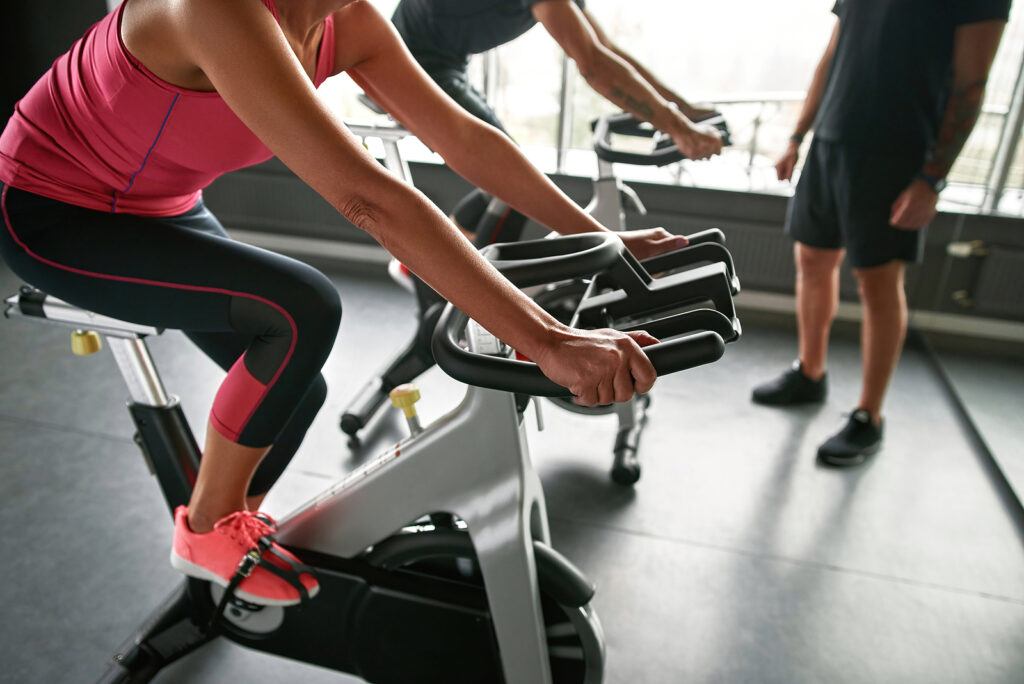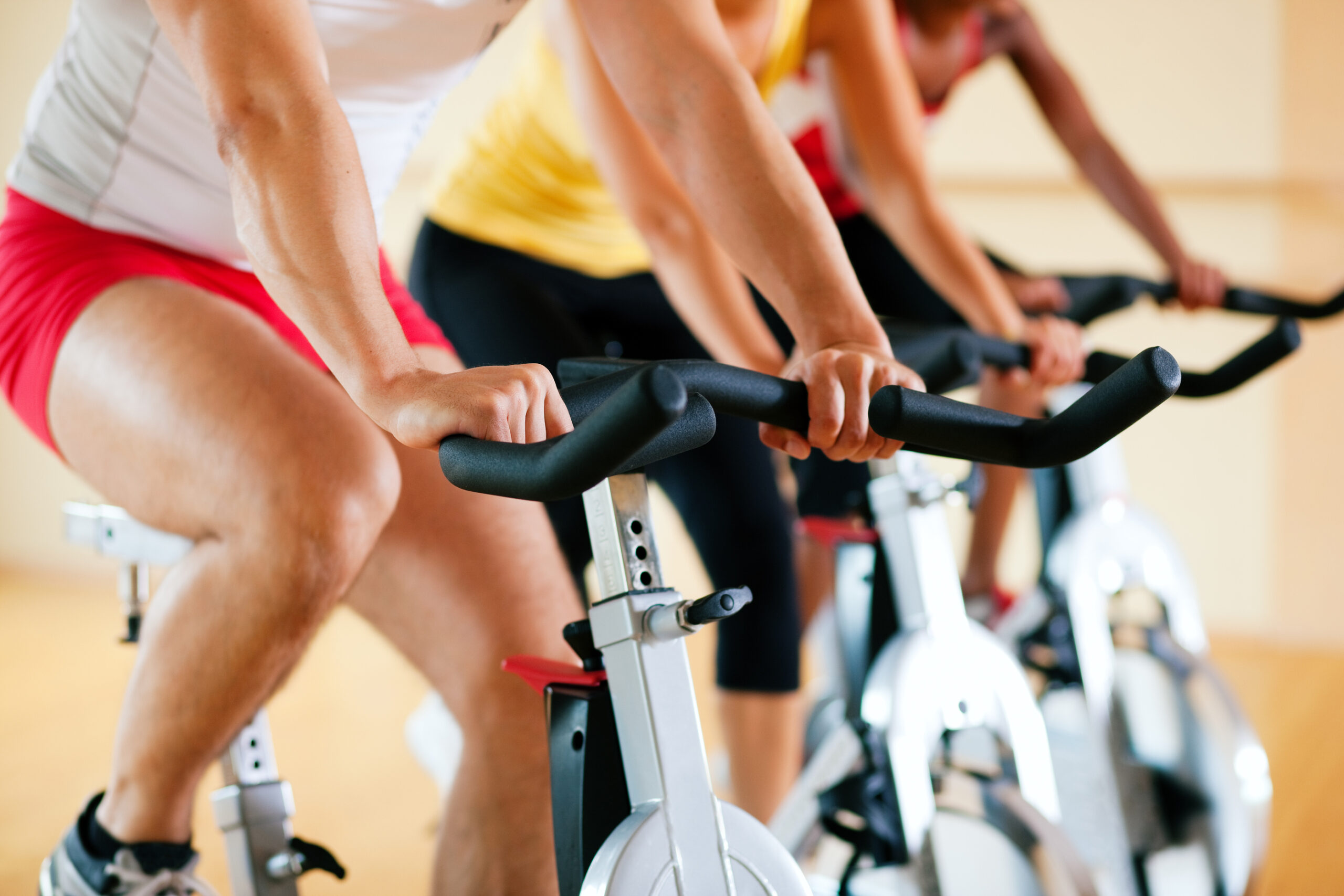Indoor cycling has become extremely popular over the last few years, mostly due to the explosion of streaming platforms and HD touchscreen consoles, but it’s not the only way to get your cycling fix.
You can also go the indoor bike trainer route, where you hook your road bike up to a resistance motor and go from there.
Bike trainers and indoor cycles can both offer great cycling workouts, but they go about it in pretty different ways.
And figuring out which option is best for you really depends on what your home situation is and what your goals are.
In this guide, I’ll be going over the key differences between indoor bike trainers and indoor cycles. I’ll also offer my 2 cents regarding the situations where each is likely the better choice.
After reading, you’ll know which options is better for your home.
Let’s do this.
Indoor Bike Trainers vs Indoor Cycles
If you’re considering using an indoor bike trainer, first and foremost, you need to have your own road/mountain bike (yes, many trainers are compatible with mountain bikes too).
Trainers are designed to hook up to an actual bicycle, so having one is kind of a prerequisite for using one.
But this is good news if you already have a bike, because it means you may be able to save quite a bit of money over buying an indoor cycle.
When it comes to bike trainers, there are 3 main types to choose from:
- Direct drive trainers
- Friction trainers
- Rollers
Direct drive trainers connect your bike directly to the resistance mechanism. With these trainers, you remove your rear wheel and your chair drive connects to the cassette on the trainer.
Direct drive trainers can offer a ton of resistance and most these days are compatible with fitness apps, but they’re also the most expensive.
Friction trainers are a little simpler because you don’t have to remove the back wheel to use these.
Instead, you place the rear wheel directly against a roller, which creates the resistance you work against.
Friction trainers are a lot more affordable than direct drive trainers, but they also can’t provide as much resistance (plus they tend to be louder and less accurate in terms of metrics).
Rollers are usually the most affordable (although here are some pretty expensive roller trainers too) and with these devices, you don’t have to worry about removing tires either.
You simply put the bike on top and start pedaling.
With roller trainers, the setup is fast, but they can also be more challenging to use from a balance standpoint.
Any style of trainer can be “smart”, simply meaning they connect with apps for data tracking or resistance control.
Indoor cycles, on the other hand, are a specific style of stationary exercise bike.
Exercise bikes come in several forms, and just like air, recumbent, and upright models, indoor cycles are a unique classification to themselves.
Indoor cycles are designed to mimic the feel of riding a road bike and in order to do this, most come with standard road bike saddles, adjustable handlebars, and heavy flywheels (although the latter isn’t a requirement, as Keiser’s M3i proves).
Indoor cycles can use magnetic systems or friction brakes to create their resistance and they each have their advantages:
Magnetic systems are smooth and quiet and don’t require maintenance since there aren’t any physically touching parts used to create the resistance.
Friction brakes are cheaper and offer micro-adjustable resistances, but they aren’t usually as smooth or quiet as magnetic systems and the felt brake pads will have to be replaced periodically.
Indoor cycles are probably the most popular type of exercise equipment at the moment and they do offer a lot of perks, including a small footprint, a wide range of features to choose from, and the fact that they come in all price ranges.

Benefits Of Indoor Bike Trainers
Now that we’ve introduced indoor bike trainers and briefly discussed what they are, let’s go over some of the biggest perks of using them:
Get to use your own bike
If you own your own bicycle, opting for a bike trainer could make sense because you don’t have to purchase another larger piece of equipment.
And if you spent a lot of money investing in your road bike, you might want to get as much use out of it as possible.
Easy to store
Another big perk of most bike trainers is that they don’t take up much space, so you can easily toss ’em in a closet when not in use.
They’re also very portable, so if you want to move ’em around the house and work out in different rooms, you surely can.
Realistic Experience
The biggest benefit is that a trainer gives you the closest experience to riding a bicycle outside.
Indoor cycles are designed to mimic this sensation too, but with a trainer, you’re on a real road bike, using your own pedals, handlebars, and gears.
This is an important one for serious and competitive cyclists that are often training for road races.
Can help you improve technique
This goes hand in hand with the point just mentioned, but since a bike trainer allows you to use your personal cycle, it makes it a lot easier to work on improving specific parts of your cycling technique.
You can practice shifting gears and cycling at differing cadences while using the same cycle you’ll be riding outside.
Disadvantages of Indoor Bike Trainers
Bike trainers have their perks, but they also have a few disadvantages worth considering:
Have to set up each time
One of the most inconvenient things about using a bike trainer is that you’ll likely have to set it up again each time you use it.
Well, if you have a dedicated cycle that you’re using with your trainer at all times (and another cycle you use outside), then you wouldn’t have to.
But for the folks who are using the same bike inside and outside, that means you’ll have to connect your bike up to that trainer every time you use it.
And if you’re using a direct drive model, that means taking off the rear wheel and hooking the drive train up to your trainer.
Not great for multiple users
If you live alone or are the only cyclist in the family, this won’t be an issue, but bike trainer don’t usually work that well for homes with multiple users.
Sure, you can adjust the seat height, but bikes come in different sizes to fit folks of different heights- so if there are multiple users of differing heights, that means you’ll have to swap the bike out each time someone else wants to use the trainer.
Can be noisy
The noise level varies from trainer to trainer, but generally speaking, bike trainers tend to be a bit louder than indoor cycles.
So, if keeping your workouts quiet is a priority (maybe you workout when other family members are sleeping), a bike trainer may not be the best option.
Can be expensive
Quality bikes aren’t cheap and neither are quality bike trainers.
Depending on what you’re looking for, you can easily spend a few hundred to a grand on a nice bike trainer… and this isn’t even including the cost of your bike itself.
Plus, not all trainers are compatible with all bikes, so you have to make sure you find a trainer that’s compatible with whatever bike you already have (or plan on getting).

Benefits of Indoor Cycles
Let’s switch gears (see what I did there?) and move on to indoor cycles. Here are a few of the benefits these exercise bikes offer:
Easy to use
Sure, you have to assemble your exercise bike after purchasing, but after that it’s ready to go whenever you are – you don’t have to worry about connecting your bike to it every time you want to ride.
Loads of features
With an indoor cycle, you can get as many or as few included features as you like.
Bike trainers also come in various levels and some are smart that can connect with apps and whatnot, but with indoor cycles, you can get features like HD consoles, built-in cooling fans, speakers, and USB charging ports.
You can also choose indoor cycles that come with built-in workout programs, making it really easy to get on and get a workout in.
Highly adjustable
Most indoor cycles come with fully adjustable seats and at least height adjustable handlebars, making them easy to adjust for users of all heights.
Many indoor cycles can comfortably accommodate folks between 5’2″ – 6’6″, making them a great choice for homes with users of varying heights.
Quiet
Indoor cycles are very quiet too… well, the good ones anyway.
Indoor cycles at all price ranges are using belt drives and magnetic resistance systems these days, so even really affordable bikes are usually pretty quiet now.
Especially when compared to most trainers.
Disadvantages of Indoor Cycles
Not as realistic
High-quality indoor cycles do a good job of mimicking the feel of riding a road bike, but they still don’t provide as real an experience as riding your own cycle on a trainer.
Especially since most exercise bikes don’t use gears or anything like that.
This might not be a big deal for your more casual cyclists, but serious competitors looking to fine tune technique should consider this.
Not as portable
Indoor cycles are a lot bigger and heavier than the smaller bike trainers, which makes them more difficult to move around.
Indoor cycles don’t take up a huge amount of floor space (most only 4′ x 2′), but it’s still a lot more than a bike trainer that’s had the bike removed.
With an indoor cycle, it’s easiest to have a dedicated space where the bike can sit at all times.
Which Makes More Sense For You?
Ok, so that’s a quick rundown on the pros and cons of bike trainers and indoor cycles.
Based on what these 2 training methods have to offer, I think bike trainers make more sense for serious cyclists than they do for people simply looking to exercise from home.
Serious cyclists will likely already own their own cycle (probably more than 1) and they’ll be more interested in practicing on their own bike.
These folks will probably be more interested in perfecting their technique with switching gears and mimicking real world scenarios too.
If you’re not an avid cyclist, you’re probably better off going with an indoor cycle.
Indoor cycles are easier to use and they’re great for homes with multiple users – plus you can get all kinds of extra features, like instructor-led workouts.
But just the convenience factor of not having to hook your bike up to the trainer every time you want to use it is probably reason enough.
In terms of cost, trainers and indoor cycles both come in a wide range of prices, so that all depends on what you’re looking for, but keep in mind all bike trainers aren’t compatible with all cycles.
Overall, bike trainers and indoor cycles can both provide a great cardiovascular workout; when deciding, it all really depends on what you’re looking for.




